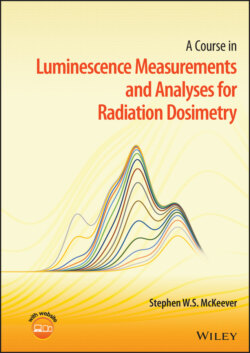Читать книгу A Course in Luminescence Measurements and Analyses for Radiation Dosimetry - Stephen W. S. McKeever - Страница 5
Contents
Оглавление1 Cover
2 Title page
3 Copyright
4 Dedication
5 Preface
6 Acknowledgments
7 Disclaimer
8 About the Companion Website
9 Part I Theory, Models, and Simulations1 Introduction1.1 How Did We Get Here?1.2 Introductory Concepts for TL, OSL, and RPL1.2.1 Equilibrium and Metastable States1.2.2 Fermi-Dirac Statistics1.2.3 Related Processes1.3 Brief Overview of Modern Applications in Radiation Dosimetry1.3.1 Personal Dosimetry1.3.2 Medical Dosimetry1.3.3 Space Dosimetry1.3.4 Retrospective Dosimetry1.3.5 Environmental Dosimetry1.4 Bibliography of Luminescence Dosimetry Applications2 Defects and Their Relation to Luminescence2.1 Defects in Solids2.1.1 Point Defects2.1.2 Extended Defects2.1.3 Non-Crystalline Materials2.2 Trapping, Detrapping, and Recombination Processes2.2.1 Excitation Probabilities2.2.1.1 Thermal Excitation2.2.1.2 Optical Excitation2.2.2 Trapping and Recombination Processes3 TL and OSL: Models and Kinetics3.1 Rate Equations: OTOR Model3.2 Analytical Solutions: TL Equations3.2.1 First-Order Kinetics3.2.2 Second-Order and General-Order Kinetics3.2.3 Mixed-Order Kinetics3.3 Analytical Solutions: OSL Equations3.3.1 First-Order Kinetics3.3.1.1 Expressions for CW-OSL3.3.1.2 Expressions for LM-OSL3.3.1.3 Expressions for POSL3.3.1.4 Expressions for VE-OSL3.3.2 Non-First-Order Kinetics3.4 More Complex Models: Interactive Kinetics3.4.1 Thermoluminescence3.4.2 Optically Stimulated Luminescence3.5 Trap Distributions3.6 Quasi-Equilibrium (QE)3.6.1 Numerical Solutions: No QE Assumption3.6.2 P and Q Analysis3.6.3 Analytical Solutions: No QE Assumption3.7 Thermal and Optical Effects3.7.1 Thermal Quenching3.7.1.1 Mott-Seitz Model3.7.1.2 Schön-Klasens Model3.7.1.3 Tests for Thermal Quenching3.7.2 Thermal Effects on OSL3.7.2.1 Effects of Shallow Traps3.7.2.2 Effects of Deep Traps: Thermally Transferred OSL (TT-OSL)3.7.3 More Temperature Effects for TL and OSL3.7.3.1 Phonon-coupling3.7.3.2 Shallow Traps3.7.3.3 Sub-Conduction Band Excitation3.7.3.4 Random Local Potential Fluctuations (RLPF)3.7.4 Optical Effects on TL3.7.4.1 Bleaching3.7.4.2 Phototransferred TL (PTTL)3.8 Tunneling, Localized and Semi-Localized Transitions3.8.1 Tunneling3.8.1.1 General Considerations3.8.1.2 Ground-State Tunneling3.8.1.3 Excited-State Tunneling3.8.1.4 Decay during Irradiation3.8.1.5 Effect of Tunneling on TL and OSL3.8.2 Localized and Semi-localized Transition Models3.8.2.1 Localized Transition Model3.8.2.2 Semi-Localized Transition Model3.8.2.3 Semi-Localized Transitions and the TL Glow Curve3.9 Master Equations4 RPL: Models and Kinetics4.1 Radiophotoluminescence and Its Differences with TL and OSL4.2 Background Considerations4.3 Buildup Kinetics4.3.1 Electronic Processes4.3.2 Ionic Processes4.3.3 More on Buildup Processes4.3.3.1 After Irradiation4.3.3.2 During Irradiation4.3.3.3 Temperature Dependence5 Analysis of TL and OSL Curves5.1 Analysis of TL Glow Curves5.2 Analytical Methods for TL5.2.1 Partial-Peak Methods5.2.1.1 A Single TL Peak with a Discrete Value for Et5.2.1.2 Multiple Overlapping Peaks, and Trap Energy Distributions5.2.2 Whole-Peak Methods5.2.3 Peak-Shape Methods5.2.4 Peak-Position Methods5.2.5 Peak-Fitting Methods5.2.5.1 Principles5.2.5.2 Peak Resolution5.2.5.3 CGCD Using More-Than-One Heating Rate5.2.5.4 Continuous Trap Distributions5.2.6 Calculation of s5.2.7 Potential Distortions to TL Glow Curves5.2.7.1 Thermal Contact5.2.7.2 Thermal Quenching5.2.7.3 Emission Spectra5.2.7.4 Self-Absorption5.2.8 Summary of Steps to Take using TL Curve Fitting5.2.9 Isothermal Analysis5.3 Analytical Methods for OSL5.3.1 Curve-Shape Methods5.3.1.1 CW-OSL5.3.1.2 LM-OSL5.3.2 Variable Stimulation Rate Methods: LM-OSL5.3.3 Curve-Fitting Methods5.3.3.1 The Curve Overlap Problem5.3.3.2 Simultaneous Fitting of LM-OSL Peaks Generated by Varying the Stimulation Rate5.3.4 How Can the Number of Traps Contributing to OSL Be Determined?5.3.4.1 tmax-tstop Analysis5.3.4.2 Comparison with TL5.3.5 Variation with Stimulation Wavelength5.3.6 Trap Distributions5.3.7 Emission Wavelength5.3.8 Summary of Steps to Take using OSL Curve Fitting5.3.9 OSL due to Optically Assisted Tunneling5.3.10 VE-OSL6 Dependence on Dose6.1 TL, OSL, or RPL versus Dose6.2 Dependence on Dose6.2.1 OTOR Model6.2.1.1 Dose-Response Relationships: Linear, Supralinear, Superlinear, and Sublinear6.2.2 Interactive Models: Competition effects6.2.2.1 Competition during Irradiation6.2.2.2 Competition during Trap Emptying6.2.3 Spatial Effects6.2.4 Sensitivity and Sensitization6.2.5 High Dose Effects6.2.5.1 Loss of Sensitivity6.2.5.2 TL and OSL Changes in Shape6.2.6 Charged Particles, Tracks, and Track Interaction6.2.6.1 Dose and Fluence Dependence: Low Fluence6.2.6.2 High Fluence: Track Interaction6.2.7 RPL6.2.7.1 Buildup during Irradiation: A Special Kind of Supralinearity6.2.7.2 Buildup after Irradiation: Linear Response to Dose
10 Part II Experimental Examples: Luminescence Dosimetry Materials7 Thermoluminescence7.1 Introduction7.2 Lithium Fluoride7.2.1 LiF:Mg,Ti7.2.1.1 Structure and Defects7.2.1.2 TL Glow Curves7.2.1.3 TL Emission Spectra7.2.1.4 TL Glow-Curve Analysis7.2.1.5 Changes to the Glow-Curve Shape with Dose and Ionization Density7.2.1.6 Competition7.2.1.7 Photon Dose-Response Characteristics7.2.1.8 Charged-Particle Dose-Response Characteristics7.2.2 LiF:MCP7.2.2.1 Structure and Defects7.2.2.2 TL Glow Curves7.2.2.3 TL Emission Spectra7.2.2.4 TL Glow-Curve Analysis7.2.2.5 Changes to the Glow-Curve Shape with Dose and Ionization Density7.2.2.6 Photon Dose-Response Characteristics7.2.2.7 Charged-Particle Dose-Response Characteristics7.2.3 Approximately Right; Precisely Wrong8 Optically Stimulated Luminescence8.1 Introduction8.2 Aluminum Oxide8.2.1 Al2O3:C8.2.1.1 Structure and Defects8.2.1.2 OSL Curves8.2.1.3 Emission and Excitation Spectra8.2.1.4 Temperature Dependence8.2.1.5 Photon Dose-Response Characteristics8.2.1.6 Charged-Particle Dose-Response Characteristics8.2.2 A Final Observation9 Radiophotoluminescence9.1 Introduction9.2 Phosphate Glass9.2.1 Ag-doped Phosphate Glass9.2.1.1 Formulation, Growth, and RPL Centers9.2.1.2 Emission and Excitation Spectra: RPL Decay Curves and Signal Measurement9.2.1.3 Buildup Curves: Temperature Dependence; UV Reversal9.2.1.4 Photon Dose-Response Characteristics9.2.1.5 Charged-Particle Dose-Response Characteristics9.2.2 Final Remarks Concerning RPL from Ag-doped Phosphate Glass9.3 Fluorescent Nuclear Track Detectors9.3.1 Al2O3:C,Mg9.3.1.1 Introduction9.3.1.2 RPL in Al2O3:C,Mg9.3.1.3 FNTD Imaging of Charged-Particle Tracks9.3.1.4 FNTD for Neutron Detection9.3.2 LiF9.3.2.1 RPL in LiF9.3.2.2 FNTD9.3.3 Alkali Phosphate Glass9.3.3.1 FNTD10 Some Examples of More Complex TL, OSL, and RPL Phenomena: The Aluminosilicates10.1 Introduction10.2 Feldspar10.2.1 Structure and Defects10.2.2 Energy Levels and Density of States10.2.3 Emission Spectra10.2.4 OSL Phenomena10.2.4.1 Band Diagram10.2.4.2 OSL Excitation Spectra10.2.4.3 OSL Curve Description10.2.5 TL Phenomena10.2.5.1 Glow-Curve Description10.2.5.2 TL Analysis10.2.6 RPL Phenomena10.2.6.1 RPL Emission and Excitation Spectra10.2.6.2 RPL Temperature Dependence10.2.7 What Can Be Concluded?10.3 Aluminosilicate Glass10.3.1 Structure and Composition10.3.2 OSL Phenomena10.3.2.1 OSL Curve Description10.3.2.2 OSL Excitation Spectrum10.3.2.3 OSL Fading10.3.2.4 Potential Uses in Radiation Dosimetry10.3.3 TL Phenomena10.3.3.1 Glow-Curve Description10.3.3.2 TL Emission Spectrum10.3.3.3 TL Analysis10.3.3.4 TL Fading10.3.3.5 Potential Uses in Radiation Dosimetry10.4 Final Remarks11 Concluding Remarks: The Possibilities for Imperfection Engineering11.1 The Importance of Defects11.1.1 The Ideal Luminescence Dosimeter11.1.2 How to Detect Defect Clustering and Tunneling11.1.2.1 Et and s Analysis11.1.2.2 TL and OSL Curve Shapes11.1.2.3 Fading11.1.2.4 Spectral Measurements11.2 The Prospects for “Designer” TLDs, OSLDs, and RPLDs
11 References
12 Index
13 End User License Agreement
